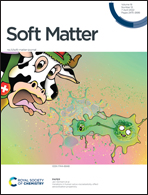Variations in human saliva viscoelasticity affect aerosolization propensity†
Abstract
Some contagious diseases, such as COVID-19, spread through the transmission of aerosols and droplets. Aerosol and droplet formation occurs inside and outside of the respiratory tract, the latter being observed during speaking and sneezing. Upon sneezing, saliva is expelled as a flat sheet, which destabilizes into filaments that subsequently break up into droplets. The presence of macromolecules (such as mucins) in saliva influences the dynamics of aerosol generation, since elasticity is expected to stabilize both fluid sheets and filaments, hence deterring droplet formation. In this study, the process of aerosol formation outside the respiratory tract is systematically replicated using an impinging jet setup, where two liquid jets collide and form a thin fluid sheet that can fragment into ligaments and droplets. The experimental setup enables us to investigate a range of dynamic conditions, quantified by the relevant non-dimensional numbers, which encompass those experienced during sneezing. Experiments are conducted with human saliva provided by different donors, revealing significant variations in their stability and breakup. We quantify the effect of viscoelasticity via shear and extensional rheology experiments, concluding that the extensional relaxation time is the most adequate measure of a saliva's elasticity. We summarize our results in terms of the dimensionless Weber, Reynolds, and Deborah numbers and construct universal state diagrams that directly compare our data to human sneezing, concluding that the aerosolization propensity is correlated with diminished saliva elasticities, higher emission velocities, and larger ejecta volumes. This could entail variations in disease transmission between individuals which hitherto have not been recognized.



 Please wait while we load your content...
Please wait while we load your content...